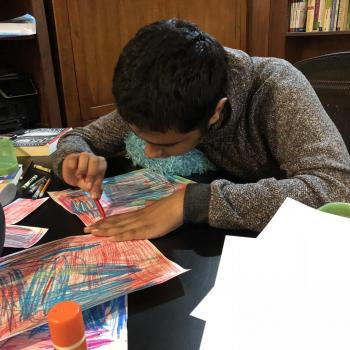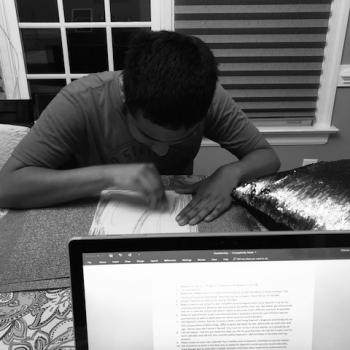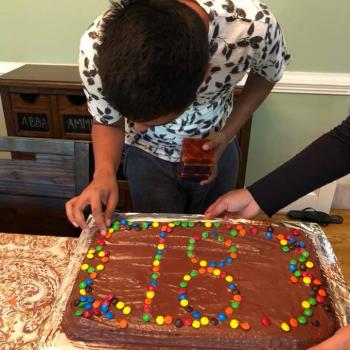Ali Family Autism Truths #14 – April 14, 2016
Hey H, I said to my youngest this morning as the kids got ready for school, I’m going to see you later today at school!
What for? He asked me.
Did you forget? I’m on lunchroom duty today!
Guess that means I have to finish all my lunch today, he quipped back at me.
I love lunchroom duty days. Every class is assigned a week to provide parent volunteers in the lunchroom, and I try to take a slot every year. Sure, it’s not anything glamourous work – you’re basically handing out forks, spoons and napkins, cutting open ketchup packets and twisting open water bottles and giving kids’ permission to get drinks from the water fountain.
But I love it. In an hour’s span, you get to see a vast majority of the schools in grades 1-5 shift in and out of the classroom in a rather stunning formation. They shuffle in, know where they have to sit, and those who get a hot lunch go get in line for their lunches. Those who bring their lunch sit down and start munching – of course dessert before main course.
Within 20 minutes, whether you finished or not, lunch is cleaned up, the kids line up and toss out their trash and go back to class. Occasionally, like today, a teacher or administrator turns the lights off when the noise level gets too loud, and quickly the buzz hum in the room dies down to a quiet murmur.
Lunch hour in the cafeteria hasn’t changed much since I was in elementary school, shuffling into the cafeteria and sitting down at tables that smelt slightly of the antiseptic spray that has just been used to clean it. It’s an array of noises, smells, bumping elbows and different foods. If the smell of boiled green beans makes your stomach turn a bit – like it did mine – then woe is unto you, because every Thursday boiled green beans were served.
It’s about the most sensory-laden place you can think of. A venerable rite of passage growing up – where do you sit? Are there assigned seats? Bring lunch from home? Buy lunch? What if you spill your lunch?
For all these reasons and more, when D transitioned to public school after two years in a private autism school, we nixed him eating in the cafeteria. I just couldn’t fathom him handling the massive overload of sensory triggers, when sitting at the table and eating independently itself was an ongoing struggle for him.
For the five years he spent in public school, D ate in his classroom. Every year when we had our IEP (individualized education plan) meeting, we revisited the idea of him eating there, but everyone felt it would be too much. By third grade though, much to my relief, his teacher instituted a “lunch bunch” program, in which groups of three kids from “regular” classrooms came to eat lunch and play games with D during his lunch break.
When D transitioned back to his private autism school in sixth grade, I mourned the loss of his lunch bunch buddies. At least that was a semblance of cafeteria normalcy that D could take part in.
About a year and a half ago, after D had been in his autism school for more than a year, I asked to observe him at lunchtime. His teachers had been telling me that he was exhibiting greater independency with his lunch routine, and I was eager to see it. During my observation, I saw him retrieve his lunch from the fridge, warm it up in a microwave (with some minimal prompting), take it to a table where other classmates were sitting, open the lid and proceed to eat.
It was a certifiable school cafeteria, with about ten tables and two to four kids sitting together at each table and eating together. Some chatted with each other or their teachers, others, like D, kept to themselves while eating. The lights were off and only natural sunlight filled the room. The noise level manageable, and kids had the option to get up and walk around while they were eating. Only one or two classrooms ate in there at time, thereby minimizing the sensory onslaught as much as possible.
Sure, it was still a bit overwhelming for some of the kids, but D was thriving. He continues to thrive, eating his lunch every day in the cafeteria amongst peers who don’t care how quirky each other gets.
The truth of it is, what you or I may deem as the “normal” or “regular” way of doing things is never the only way of doing things. Among the many things D and his autism has taught me, this is a lesson repeated over and over again – there is always a way.
Stay in touch! Like Muslimah Next Door on Facebook:












